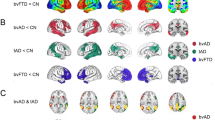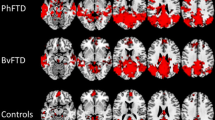Abstract
Purpose
The diagnosis of behavioural variant frontotemporal dementia (bvFTD) is challenging during the predementia stage when symptoms are subtle and confounding. Morphological and functional neuroimaging can be particularly helpful during this stage but few data are available.
Methods
We retrospectively selected 25 patients with late-onset probable bvFTD. Brain structural MRI and FDG PET were performed during the predementia stage (mean MMSE score 27.1 ± 2.5) on average 2 years before. The findings with the two imaging modalities were compared (SPM8) with those in a group of 20 healthy subjects. The bvFTD patients were divided into two subgroups: those with predominant disinhibition (bvFTD+) and those with apathy (bvFTD−).
Results
Hypometabolism exceeded grey matter (GM) density reduction in terms of both extension and statistical significance in all comparisons. In the whole bvFTD group, hypometabolism involved the bilateral medial, inferior and superior lateral frontal cortex, anterior cingulate, left temporal and right parietal cortices and the caudate nuclei. GM density reduction was limited to the right frontal cortex and the left medial temporal lobe. In bvFTD+ patients hypometabolism was found in the bilateral medial and basal frontal cortex, while GM reduction involved the left anterior cingulate and left inferior frontal cortices, and the right insula. In bvFTD− patients, atrophy and mainly hypometabolism involved the lateral frontal cortex and the inferior parietal lobule.
Conclusion
These findings suggest that hypometabolism is more extensive than, and thus probably precedes, atrophy in predementia late-onset bvFTD, underscoring different topographic involvement in disinhibited and apathetic presentations. If confirmed in a larger series, these results should prompt biomarker operationalization in bvFTD, especially for patient selection in therapeutic clinical trials.


Similar content being viewed by others
References
Perry DC, Miller BL. Frontotemporal dementia. Semin Neurol. 2013;33:336–41.
Seltman RE, Matthews BR. Frontotemporal lobar degeneration: epidemiology, pathology, diagnosis and management. CNS Drugs. 2012;26:841–70.
Rascovsky K, Hodges JR, Knopman D, Mendez MF, Kramer JH, Neuhaus J, et al. Sensitivity of revised diagnostic criteria for the behavioural variant of frontotemporal dementia. Brain. 2011;134:2456–77.
de Mendonça A, Ribeiro F, Guerreiro M, Garcia C. Frontotemporal mild cognitive impairment. J Alzheimers Dis. 2004;6:1–9.
Snowden JS, Bathgate D, Varma A, Blackshaw A, Gibbons ZC, Neary D. Distinct behavioural profiles in frontotemporal dementia and semantic dementia. J Neurol Neurosurg Psychiatry. 2001;70:323–32.
Le Ber I, Guedj E, Gabelle A, Verpillat P, Volteau M, Thomas-Anterion C, et al. Demographic, neurological and behavioural characteristics and brain perfusion SPECT in frontal variant of frontotemporal dementia. Brain. 2006;129:3051–65.
Taragano FE, Allegri RF, Krupitzki H, Sarasola DR, Serrano CM, Loñ L, et al. Mild behavioral impairment and risk of dementia: a prospective cohort study of 358 patients. J Clin Psychiatry. 2009;70:584–92.
Albert MS, DeKosky ST, Dickson D, Dubois B, Feldman HH, Fox NC, et al. The diagnosis of mild cognitive impairment due to Alzheimer’s disease: recommendations from the National Institute on Aging-Alzheimer’s Association workgroups on diagnostic guidelines for Alzheimer’s disease. Alzheimers Dement. 2011;7:270–9.
Whitwell JL, Josephs KA. Neuroimaging in frontotemporal lobar degeneration – predicting molecular pathology. Nat Rev Neurol. 2012;8:131–42.
Whitwell JL, Jack Jr CR, Parisi JE, Knopman DS, Boeve BF, Petersen RC, et al. Imaging signatures of molecular pathology in behavioral variant frontotemporal dementia. J Mol Neurosci. 2011;45:372–8.
Schroeter ML, Vogt B, Frisch S, Becker G, Seese A, Barthel H, et al. Dissociating behavioral disorders in early dementia – an FDG-PET study. Psychiatry Res. 2011;194:235–44.
Raczka KA, Becker G, Seese A, Frisch S, Heiner S, Marschhauser A, et al. Executive and behavioral deficits share common neural substrates in frontotemporal lobar degeneration – a pilot FDG-PET study. Psychiatry Res. 2010;182:274–80.
Mendez MF, McMurtray A, Chen AK, Shapira JS, Mishkin F, Miller BL. Functional neuroimaging and presenting psychiatric features in frontotemporal dementia. J Neurol Neurosurg Psychiatry. 2006;77:4–7.
Chiu WZ, Papma JM, de Koning I, Donker Kaat L, Seelaar H, Reijs AE, et al. Midcingulate involvement in progressive supranuclear palsy and tau positive frontotemporal dementia. J Neurol Neurosurg Psychiatry. 2012;83:910–5.
Woost TB, Dukart J, Frisch S, Barthel H, Sabri O, Mueller K, et al. Neural correlates of the DemTect in Alzheimer’s disease and frontotemporal lobar degeneration – a combined MRI & FDG-PET study. Neuroimage Clin. 2013;2:746–58.
Jacova C, Hsiung GY, Tawankanjanachot I, Dinelle K, McCormick S, Gonzalez M, et al. Anterior brain glucose hypometabolism predates dementia in progranulin mutation carriers. Neurology. 2013;81:1322–31.
Kerklaan BJ, van Berckel BN, Herholz K, Dols A, van der Flier WM, Scheltens P, et al. The added value of 18-fluorodeoxyglucose- positron emission tomography in the diagnosis of the behavioral variant of frontotemporal dementia. Am J Alzheimers Dis Other Demen. 2014;29:607–13.
Mosconi L, Tsui WH, Herholz K, Pupi A, Drzezga A, Lucignani G, et al. Multicenter standardized 18F-FDG PET diagnosis of mild cognitive impairment, Alzheimer’s disease, and other dementias. J Nucl Med. 2008;49:390–8.
Krudop WA, Kerssens CJ, Dols A, Prins ND, Möller C, Schouws S, et al. Identifying bvFTD within the wide spectrum of late onset frontal lobe syndrome: a clinical approach. Am J Geriatr Psychiatry. 2015;23:1056–66. doi:10.1016/j.jagp.2015.04.002.
Magistretti PJ. Cellular bases of functional brain imaging: insights from neuron-glia metabolic coupling. Brain Res. 2000;886:108–12.
Origone P, Accardo J, Verdiani S, Lamp M, Arnaldi D, Bellone E, et al. Neuroimaging features in C9orf72 and TARDBP double mutation with FTD phenotype. Neurocase. 2015;21:529–34.
Morris JC. The Clinical Dementia Rating (CDR): current version and scoring rules. Neurology. 1993;43:2412–4.
Wahlund LO, Barkhof F, Fazekas F, Bronge L, Augustin M, Sjögren M, et al. A new rating scale for age-related white matter changes applicable to MRI and CT. Stroke. 2001;32:1318–22.
Morbelli S, Drzezga A, Perneczky R, Frisoni GB, Caroli A, van Berckel BN, et al. Resting metabolic connectivity in prodromal Alzheimer’s disease. A European Alzheimer Disease Consortium (EADC) project. Neurobiol Aging. 2012;33:2533–50.
Varrone A, Asenbaum S, Vander Borght T, Booij J, Nobili F, Någren K, et al. EANM procedure guidelines for PET brain imaging using [18F]FDG, version 2. Eur J Nucl Med Mol Imaging. 2009;36:2103–10.
Good CD, Johnsrude IS, Ashburner J, Henson RN, Friston KJ, Frackowiak RS. A voxel-based morphometric study of ageing in 465 normal adult human brains. Neuroimage. 2001;14:21–36.
Oishi N, Udaka F, Kameyama M, Sawamoto N, Hashikawa K, Fukuyama H. Regional cerebral blood flow in Parkinson disease with nonpsychotic visual hallucinations. Neurology. 2005;65:1708–15.
Eickhoff SB, Laird AR, Grefkes C, Wang LE, Zilles K, Fox PT. Coordinate-based activation likelihood estimation meta-analysis of neuroimaging data: a random-effects approach based on empirical estimates of spatial uncertainty. Hum Brain Mapp. 2009;30:2907–26.
Deters KD, Risacher SL, Farlow MR, Unverzagt FW, Kareken DA, Hutchins GD, et al. Cerebral hypometabolism and grey matter density in MAPT intron 10 +3 mutation carriers. Am J Neurodegener Dis. 2014;3:103–14.
Dukart J, Mueller K, Horstmann A, Barthel H, Möller HE, Villringer A, et al. Combined evaluation of FDG-PET and MRI improves detection and differentiation of dementia. PLoS One. 2011;6:e18111.
Rajagopalan V, Pioro EP. Comparing brain structural MRI and metabolic FDG-PET changes in patients with ALS-FTD: ‘the chicken or the egg?’ question. J Neurol Neurosurg Psychiatry. 2015;86:952–8. doi:10.1136/jnnp-2014-308239.
Rabinovici GD, Boeve BF. Imaging prodromal FTD: seeing the future through PET crystals. Neurology. 2013;81:1282–3.
Kipps CM, Hodges JR, Fryer TD, Nestor PJ. Combined magnetic resonance imaging and positron emission tomography brain imaging in behavioural variant frontotemporal degeneration: refining the clinical phenotype. Brain. 2009;132:2566–78.
Morbelli S, Piccardo A, Villavecchia G, Dessi B, Brugnolo A, Piccini A, et al. Mapping brain morphological and functional conversion patterns in amnestic MCI: a voxel-based MRI and FDG-PET study. Eur J Nucl Med Mol Imaging. 2010;37:36–45.
Kipps CM, Davies RR, Mitchell J, Kril JJ, Halliday GM, Hodges JR. Clinical significance of lobar atrophy in frontotemporal dementia: application of an MRI visual rating scale. Dement Geriatr Cogn Disord. 2007;23:334–42.
Caroli A, Lorenzi M, Geroldi C, Nobili F, Paghera B, Bonetti M, et al. Metabolic compensation and depression in Alzheimer’s disease. Dement Geriatr Cogn Disord. 2010;29:37–45.
Ye BS, Choi SH, Han SH, Kim S, Yang DW, Park KH, et al. Clinical and neuropsychological comparisons of early-onset versus late-onset frontotemporal dementia: a CREDOS-FTD study. J Alzheimers Dis. 2015;45:599–608.
Passant U, Rosén I, Gustafson L, Englund E. The heterogeneity of frontotemporal dementia with regard to initial symptoms, qEEG and neuropathology. Int J Geriatr Psychiatry. 2005;20:983–8.
Nobili F, Campus C, Arnaldi D, De Carli F, Cabassi G, Brugnolo A, et al. Cognitive-nigrostriatal relationships in de novo, drug-naïve Parkinson’s disease patients: a [I-123]FP-CIT SPECT study. Mov Disord. 2010;25:35–43.
Zamboni G, Huey ED, Krueger F, Nichelli PF, Grafman J. Apathy and disinhibition in frontotemporal dementia: insights into their neural correlates. Neurology. 2008;71:736–42.
Rosen HJ, Perry RJ, Murphy J, Kramer JH, Mychack P, Schuff N, et al. Emotion comprehension in the temporal variant of frontotemporal dementia. Brain. 2002;125:2286–95.
Morgane PJ, Galler JR, Mokler DJ. A review of systems and networks of the limbic forebrain/limbic midbrain. Prog Neurobiol. 2005;75:143–60.
Links KA, Chow TW, Binns M, Freedman M, Stuss DT, Scott CJ, et al. Apathy is not associated with basal ganglia atrophy in frontotemporal dementia. Am J Geriatr Psychiatry. 2009;17:819–21.
Paulus MP, Stein MB. An insular view of anxiety. Biol Psychiatry. 2006;60:383–7.
Knopman DS, Kramer JH, Boeve BF, Caselli RJ, Graff-Radford NR, Mendez MF, et al. Development of methodology for conducting clinical trials in frontotemporal lobar degeneration. Brain. 2008;131:2957–68.
Author information
Authors and Affiliations
Corresponding author
Ethics declarations
Conflicts of interest
This study received no sponsorship. Dr. Morbelli received honoraria to teach amyloid PET reading on behalf of Eli-Lilly & Co. in 2014 – 2015. Dr. Nobili received honoraria to teach amyloid PET reading on behalf of Eli-Lilly & Co. in 2014 – 2015. He received speaker honoraria from G.E. Healthcare in 2015. The other authors have nothing to disclose.
Ethical approval
All procedures performed in studies involving human participants were in accordance with the ethical standards of the institutional and/or national research committee and with the principles of the 1964 Declaration of Helsinki and its later amendments or comparable ethical standards. The study protocol was approved by the local Ethics Committee.
Informed consent
Informed consent was obtained from all individual participants included in the study.
Rights and permissions
About this article
Cite this article
Morbelli, S., Ferrara, M., Fiz, F. et al. Mapping brain morphological and functional conversion patterns in predementia late-onset bvFTD. Eur J Nucl Med Mol Imaging 43, 1337–1347 (2016). https://doi.org/10.1007/s00259-016-3335-3
Received:
Accepted:
Published:
Issue Date:
DOI: https://doi.org/10.1007/s00259-016-3335-3




